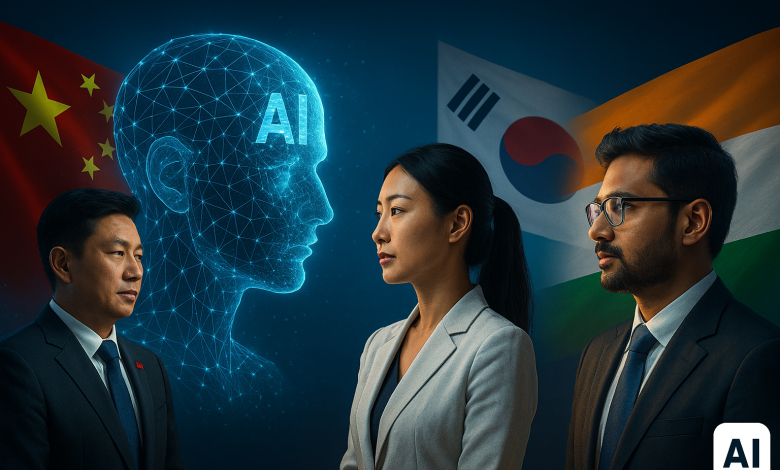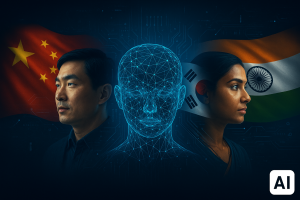What AI Does in Chinese, Korean, and Indian Ways: A Comparison of Approaches to Development

The development of artificial intelligence in Asia is not consistent. Although all three countries, China, South Korea, and India, focus on AI, their approaches and objectives are starkly different. Such differences are indications of political systems, economic approaches, and cultural models that define the way each nation incorporates AI into society.
China is biased towards centralized planning, government-supported platforms, and integration on the infrastructure level. South Korea focuses on industrial AI, robotics, and corporate innovation. India strikes the right balance between the adoption of the public sector and grassroots innovation and open data. Both directions provide us with an understanding of the way AI transforms governance, economy, and even culture.
Centralized and Scalable AI in China
China has rolled out several broad national plans and funneled massive state money into artificial intelligence. Its 2017 “Next Generation Artificial Intelligence Development Plan” aims to crown the country global AI champ by 2030, emphasizing security, public monitoring, automated transport, and factory efficiency.
Because of this drive, Beijing backs big-ticket projects in facial recognition, social-credit scoring, and self-driving cars. The central government props up tech giants like Baidu, Alibaba, and Tencent as they build the nation’s core AI tools. Real-time feeds from cameras, sensors, and biometric scanners then fuel algorithms that manage traffic, predict crime, and control other smart-city services.
China’s commercial AI applications are also expanding rapidly. Platforms use AI to personalize digital content, assist e-commerce, and enhance mobile functionality, similar to what the best bet app in Pakistan achieves with adaptive interfaces. These integrations rely on massive datasets and relaxed privacy norms, allowing AI to evolve fast and at scale.
At the local level, municipalities like Hangzhou and Shenzhen lead AI trials for waste management, healthcare triage, and logistics coordination. Educational platforms use AI to monitor student progress and suggest curriculum tweaks. However, these deployments are not without criticism. Concerns around surveillance and algorithmic bias have drawn attention from global rights organizations.
Table: AI Strategy Comparison
| Country | Policy Focus | Key Sectors | Lead Institutions | Controversies |
| China | National control, urban AI | Surveillance, logistics | Tsinghua, Baidu | Privacy, overreach |
| South Korea | Industrial AI, global markets | Robotics, semiconductors | KAIST, Samsung | Workforce displacement |
| India | Inclusion, public access | Health, agriculture, fintech | NITI Aayog, IITs | Infrastructure fragmentation |
South Korea’s Model: Industrial and Export-Driven
South Korea has tied its whole AI push to boosting industry, not running it from one big office. The government wants cars, semiconductors, and home robots to work smarter, so engineers build AI tools that polish each step of production. In 2022, the Administration rolled out the Korean New Deal 2.0 and promised over $1 billion to keep research moving.
AI already pops up in everyday gadgets. Samsung’s smart-home platform learns when lights should dim, and LG’s factory robots shuffle parts faster while wasting less power. Hospitals use voice AI to log notes, and wearables that count steps or track heart rates target people who care about staying healthy.
The nation is also leaning on AI in sports and esports, using AI to model moves, study playerstats, and rev up fan apps. Some betting sites, similar to MelBet online betting, mix live numbers with forward-looking models, making players feel more involved. Publishers and streamers tap neural nets to tweak what people see in real time.
Korea Advanced Institute of Science and Technology, or KAIST, now ranks as a global AI hub. Its grad programs feed talent to tech firms and government labs. Alongside that, the Digital New Deal plan aims to add 200,000 AI jobs by 2025, spreading opportunity across the economy.
Indian Way: Decentralized and Inclusive
The model of AI development in India is led by access, scale, and public-private partnerships. The National Strategy on AI, published by NITI Aayog, focuses on the concept of AI for All, which is meant to address inequality and increase digital literacy.
Instead of top-down management, India markets grassroots innovation. The application of AI is also in agriculture (predicting crop diseases), in the sphere of public health (diagnosis of TB), and in education (through adaptive learning platforms). CoWIN, the online backbone of India’s COVID-19 vaccination, relied on AI to optimize logistics, eliminate fraud, and target better.
The AI infrastructure in India remains disjointed. Deployment is hampered by the lack of internet connectivity and data quality inconsistencies. Nonetheless, the nation makes up for it by having a thriving startup culture. AI ventures are found in Bengaluru, Hyderabad, and Pune in edtech, esports, and mobile development.
Startups can develop AI applications using real-life data provided by government-supported data sets such as DigiLocker and IndiaStack. The outcome is an expanding ecosystem that combines global capital, open APIs, and community testing.
Artificial intelligence is also finding its way into Indian sports. Pose estimation, motion tracking, and injury risk analysis are used on training platforms. The teams in the Indian Premier League (IPL) are starting to incorporate AI in fan behavior analytics and sponsorship planning. These tools are similar to the larger engagement approaches found on betting-adjacent websites but are based on performance statistics rather than bets.

Unique Cultural Dimensions and Governance Models
Societal values determine the AI course in every country. In China, order and efficiency are valued. People are usually okay with AI as long as it enhances their services, even in instances where their privacy is not respected. The Chinese education system also focuses on STEM subjects at an early age, which fills the pipeline of the AI workforce.
South Korea is focused on design and functionality. High consumer demand for AI-integrated goods is influenced by cultural respect for technology and a healthy job market. The business is in a race to launch smarter and sleeker products that can be used in industries and at home.
Instead, India focuses on digital inclusion. AI projects should be sensitive to linguistic and income disparities and regional requirements. This exerts pressure to develop powerful and low-cost systems that perform on old machines and unstable networks.
There are also differences in AI ethics. In China and South Korea, ethics guidelines are state-led and are frequently in line with industrial or geopolitical interests. The ethical debates in India are more scholarly and include the civil society and the courts. The facial recognition and AI bias debates are more open and connected with constitutional issues.
Startup Growth and Tech Talent
AI talent is not equally available in these countries. China produces engineers in large numbers with strict control over international research exchange. South Korea is a mixture of top-tier universities and corporate training pipelines. India, even with its infrastructure shortcomings, has been able to create world-class software engineers, with many of them being employed in AI labs around the world.
There is an increasing role of accelerators and incubators. The Chinese government has sponsored areas such as Zhongguancun in Beijing that cluster AI startups. South Korea has initiatives such as SparkLabs and Naver D2 to build AI-based consumer and sports technology. In India, T-Hub and NASSCOM operate accelerators that link AI companies to government-funded data.
Every ecosystem is strong. China has rapid scalability. Korea ensures the integration of manufacturing and design. India offers flexibility, multilingual services, and international software platforms.



